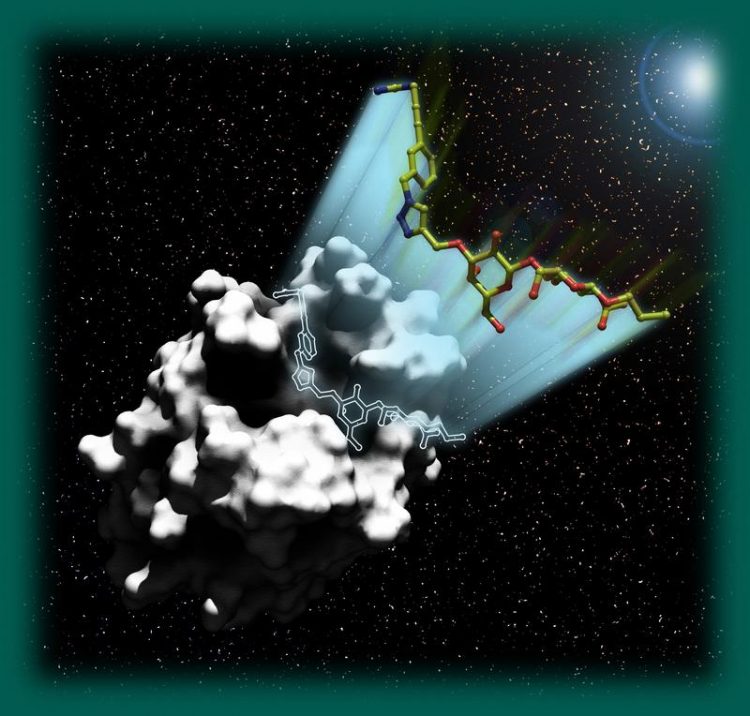Cancer detection with sugar molecules

Like a spaceship, the complex sugar molecule (coloured) lands exactly on the tumor protein galectin-1, which here looks like a meteorite and is shown in black and white. Picture: Workgroup Seibel, VCH-Wiley
Galectins are a family of proteins that have become a promising source of cancer research in recent years. A representative thereof is galectin-1.
It sits on the surface of all human cells; on tumor cells, however, it occurs in enormous quantities. This makes it an interesting target for diagnostics and therapy.
“Among other things, it is known that galectin-1 hides the tumor cells from the immune system,” explains Professor Jürgen Seibel of the Institute of Organic Chemistry at the Julius-Maximilians-Universität (JMU) Würzburg in Bavaria, Germany.
Recent studies have shown that when Galectin-1 is blocked, the immune system can recognize the tumor and attack it with T cells.
Sugar molecule with docking station
No wonder, therefore, that galectin-1 has become a major focus of research. Seibel and his colleague Dr. Clemens Grimm is interested in a very specific section of this protein, the so-called carbohydrate recognition domain. They have now designed a complex sugar molecule that fits perfectly into this domain, as the scientists report in journal “ChemBioChem”.
“We have equipped the sugar molecule with a docking site, for example, to connect it with a fluorescent dye or an drug,” says Seibel. In addition, the scientists have described the binding of their molecule to galectin-1 with high-resolution X-ray structure analyzes.
“Our findings can serve the development of high-affinity ligands of the protein Galectin-1 and thus of new drugs,” said Clemens Grimm.
Quick test for Galectin-1 in progress
Now the JMU scientists are working on a rapid test for the detection of galectin-1. It is designed to enable early detection of tumors such as neuroblastoma. For the future, Seibel's team would like to expand the sugar molecules into a kind of shuttle system that allows pharmaceutical agents to be transported directly to the tumors.
“Exploring the Structural Space of the Galectin-1–Ligand Interaction”, Nadja Bertleff-Zieschang, Julian Bechold, Clemens Grimm, Michael Reutlinger, Petra Schneider, Gisbert Schneider, Jürgen Seibel, ChemBioChem, 4. August 2017, DOI: 10.1002/cbic.201700251
Contact
Prof. Dr. Jürgen Seibel, Institute of Organic Chemistry, JMU, T +49 931 31-85326, seibel@chemie.uni-wuerzburg.de
Dr. Clemens Grimm, Institute of Organic Chemistry, JMU, T +49 931 31-84031, Clemens.Grimm@biozentrum.uni-wuerzburg.de
Media Contact
More Information:
http://www.uni-wuerzburg.deAll latest news from the category: Life Sciences and Chemistry
Articles and reports from the Life Sciences and chemistry area deal with applied and basic research into modern biology, chemistry and human medicine.
Valuable information can be found on a range of life sciences fields including bacteriology, biochemistry, bionics, bioinformatics, biophysics, biotechnology, genetics, geobotany, human biology, marine biology, microbiology, molecular biology, cellular biology, zoology, bioinorganic chemistry, microchemistry and environmental chemistry.
Newest articles

NASA: Mystery of life’s handedness deepens
The mystery of why life uses molecules with specific orientations has deepened with a NASA-funded discovery that RNA — a key molecule thought to have potentially held the instructions for…

What are the effects of historic lithium mining on water quality?
Study reveals low levels of common contaminants but high levels of other elements in waters associated with an abandoned lithium mine. Lithium ore and mining waste from a historic lithium…

Quantum-inspired design boosts efficiency of heat-to-electricity conversion
Rice engineers take unconventional route to improving thermophotovoltaic systems. Researchers at Rice University have found a new way to improve a key element of thermophotovoltaic (TPV) systems, which convert heat…



